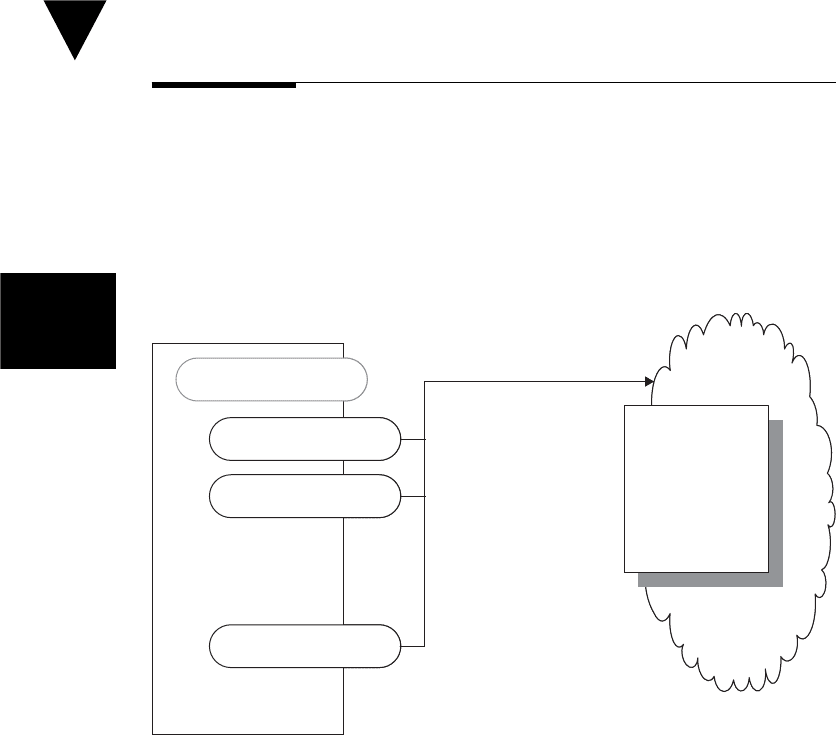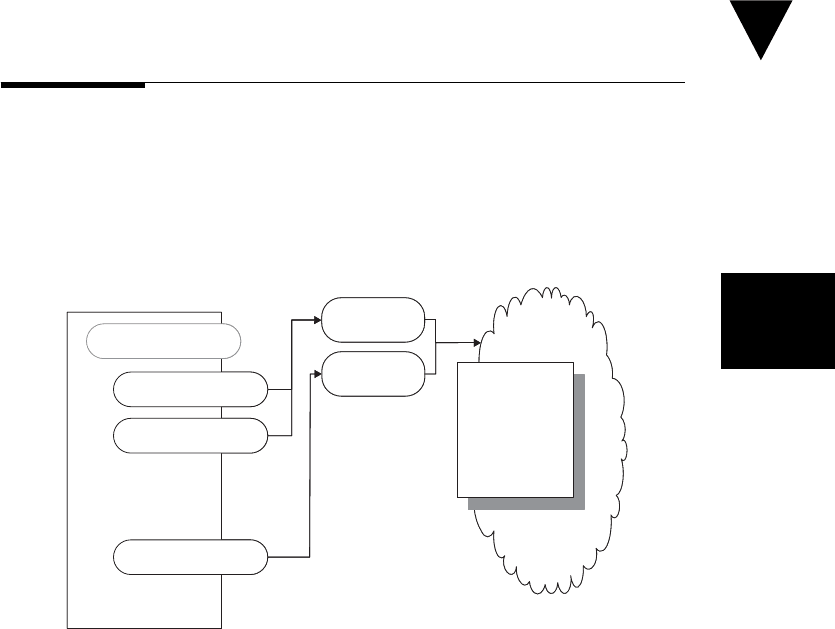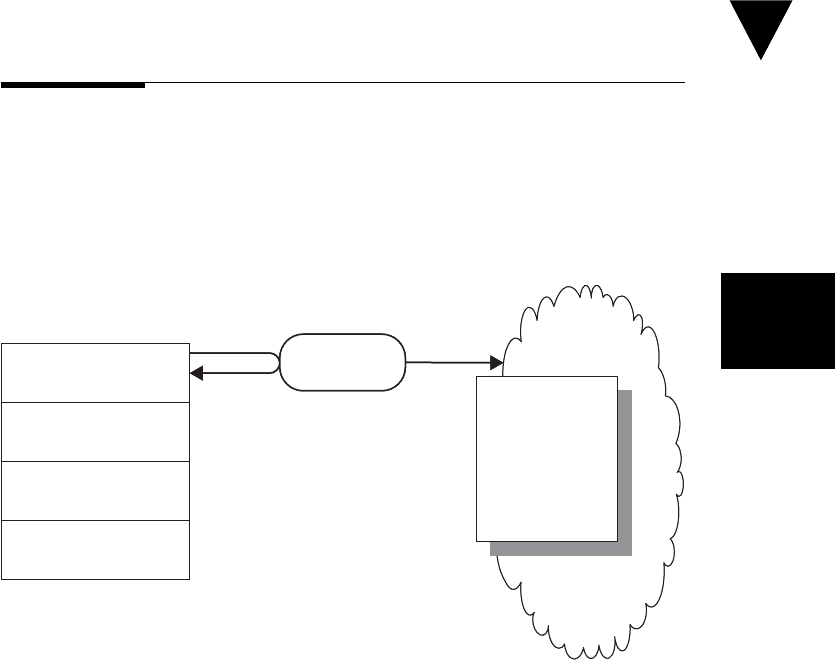Meszaros G. xUnit Test Patterns Refactoring Test Code
Подождите немного. Документ загружается.


In-line Setup
How do we construct the Fresh Fixture?
Each Test Method creates its own Fresh Fixture by calling the
appropriate constructor methods to build exactly the test fi xture
it requires.
To execute an automated test, we require a text fi xture that is well understood
and completely deterministic. We can use the Fresh Fixture (page 311) approach
to build a Minimal Fixture (page 302) for the use of this one test. Setting up the
test fi xture on an in-line basis in each test is the most obvious way to build it.
How It Works
Each Test Method (page 348) sets up its own test fi xture by directly calling what-
ever SUT code is required to construct exactly the test fi xture it requires. We put
the code that creates the fi xture, the fi rst phase of the Four-Phase Test (page 358),
at the top of each Test Method.
Fixture
SUT
Testcase Class
setUp
test_1
test_2
test_n
Setup
Fixture
SUT
Testcase Class
setUp
test_1
test_2
test_n
Setup
In-line Setup
Chapter 20 Fixture Setup Patterns
408

When to Use It
We can use In-line Setup when the fi xture setup logic is very simple and straightforward.
As soon as the fi xture setup gets at all complex, we should consider using Delegated
Setup (page 411) or Implicit Setup (page 424) for part or all of the fi xture setup.
We can also use In-line Setup when we are writing a fi rst draft of tests and haven’t
yet fi gured out which part of the fi xture setup will be repeated from test to test.
This is an example of applying the “Red–Green–Refactor” process pattern to the
tests themselves. Nevertheless, we need to be careful when we refactor the tests to
ensure that we don’t break the tests in ways that are undetectable.
A third occasion to use In-line Setup is when refactoring obtuse fi xture setup
code. A fi rst step may be to use In-line Method [Fowler] refactorings on all
Creation Methods (page 415) and the setUp method. Then we can try using a
series of Extract Method [Fowler] refactorings to defi ne a new set of Creation
Methods that are more intent-revealing and reusable.
Implementation Notes
In practice, most fi xture setup logic will include a mix of styles, such as In-line
Setup building on top of Implicit Setup or Delegated Setup interspersed with
In-line Setup.
Example: In-line Setup
Here’s an example of simple in-line setup. Everything each Test Method needs
for exercising the SUT is included in-line.
public void testStatus_initial() {
// in-line setup
Airport departureAirport = new Airport("Calgary", "YYC");
Airport destinationAirport = new Airport("Toronto", "YYZ");
Flight flight = new Flight( flightNumber,
departureAirport,
destinationAirport);
// exercise SUT and verify outcome
assertEquals(FlightState.PROPOSED, flight.getStatus());
// tearDown:
// garbage-collected
}
public void testStatus_cancelled() {
// in-line setup
Airport departureAirport = new Airport("Calgary", "YYC");
Airport destinationAirport = new Airport("Toronto", "YYZ");
In-line Setup
In-line Setup
409

410
Flight flight = new Flight( flightNumber,
departureAirport,
destinationAirport);
flight.cancel(); // still part of setup
// exercise SUT and verify outcome
assertEquals(FlightState.CANCELLED, flight.getStatus());
// tearDown:
// garbage-collected
}
Refactoring Notes
In-line Setup is normally the starting point for refactoring, not the end goal.
Sometimes, however, we fi nd ourselves with tests that are too hard to under-
stand because of all the stuff happening behind the scenes, which is a form of
Mystery Guest (see Obscure Test on page 186). At other times, we may fi nd
ourselves modifying the previously setup fi xture in many of the tests.
Both of these situations are indications it may be time to refactor our test
class into multiple classes based on the fi xture they build. First, we use an In-
line Method refactoring on the code to produce an In-line Setup. Next, we
reorganize the tests using an Extract Class [Fowler] refactoring. Finally, we use
a series of Extract Method refactorings to defi ne a more understandable set of
fi xture setup methods.
In-line Setup
Chapter 20 Fixture Setup Patterns

Delegated Setup
How do we construct the Fresh Fixture?
Each Test Method creates its own Fresh Fixture by calling Creation Methods
from within the Test Methods.
To execute an automated test, we require a text fi xture that is well understood
and completely deterministic. We are using a Fresh Fixture (page 311) approach
to build a Minimal Fixture (page 302) for the use of this one test and we’d like
to avoid Test Code Duplication (page 213).
Delegated Setup lets us reuse the code to set up the fi xture without compromis-
ing our goal of Tests as Documentation (see page 23).
How It Works
Each Test Method (page 348) sets up its own test fi xture by calling one or more
Creation Methods (page 415) to construct exactly the test fi xture it requires.
To ensure Tests as Documentation, we build a Minimal Fixture using Creation
Methods that build fully formed objects that are ready for use by the test. We
strive to ensure that the method calls will convey the “big picture” to the test
reader by passing in only those values that affect the behavior of the SUT.
Fixture
SUT
Utility
Method
Testcase Class
setUp
test_1
test_2
test_n
Utility
Method
Setup
Fixture
SUT
Utility
Method
Testcase Class
setUp
test_1
test_2
test_n
Utility
Method
Setup
Delegated
Setup
Delegated Setup
411

412
When to Use It
We can use a Delegated Setup when we want to avoid the Test Code Duplication
caused by having to set up similar fi xtures for several tests and we want to keep
the nature of the fi xture visible within the Test Methods. A reasonable goal is to
encapsulate the essential but irrelevant steps of setting up the fi xture and leave
only the steps and values essential to understanding the test within the Test Meth-
od. This scheme helps us achieve Tests as Documentation by ensuring that excess
In-line Setup (page 408) code does not obscure the intent of the test. It also avoids
the Mystery Guest problem (see Obscure Test on page 186) by leaving the Intent-
Revealing Name [SBPP] of the Creation Method call within the Test Method.
Furthermore, Delegated Setup allows us to use whatever organization scheme
we want for our Test Methods. In particular, we are not forced to put Test Methods
that require the same test fi xture into the same Testcase Class (page 373) just to
reuse the setUp method as we would have to when using Implicit Setup (page 424).
Furthermore, Delegated Setup helps prevent Fragile Tests (page 239) by moving
much of the nonessential interaction with the SUT out of the very numerous Test
Methods and into a much smaller number of Creation Method bodies, where it is
easier to maintain.
Implementation Notes
With modern refactoring tools, we can often create the fi rst cut of a Creation
Method by performing a simple Extract Method [Fowler] refactoring. As we are
writing a set of tests using “clone and twiddle,” we must watch for any Test Code
Duplication in the fi xture setup logic within our tests. For each object that needs to
be verifi ed in the verifi cation logic, we extract a Creation Method that takes only
those attributes as parameters that affect the outcome of the test.
Initially, we can leave the Creation Method on our Testcase Class. If we need
to share them with another class, however, we can move the Creation Methods
to an Abstract Testcase class (see Testcase Superclass on page 638) or a Test
Helper (page 643) class.
Motivating Example
Suppose we are testing the state model of the Flight class. In each test, we need
to have a fl ight in the right state. Because a fl ight needs to connect at least two
airports, we need to create airports before we can create a fl ight. Of course, air-
ports are typically associated with cities or states/provinces. To keep the example
manageable, let’s assume that our airports require only a city name and an air-
port code.
Delegated
Setup
Chapter 20 Fixture Setup Patterns

413
public void testStatus_initial() {
// in-line setup
Airport departureAirport = new Airport("Calgary", "YYC");
Airport destinationAirport = new Airport("Toronto", "YYZ");
Flight flight = new Flight(flightNumber,
departureAirport,
destinationAirport);
// exercise SUT and verify outcome
assertEquals(FlightState.PROPOSED, flight.getStatus());
// teardown
// garbage-collected
}
public void testStatus_cancelled() {
// in-line setup
Airport departureAirport = new Airport("Calgary", "YYC");
Airport destinationAirport = new Airport("Toronto", "YYZ");
Flight flight = new Flight( flightNumber,
departureAirport,
destinationAirport);
flight.cancel(); // still part of setup
// Exercise SUT and verify outcome
assertEquals(FlightState.CANCELLED, flight.getStatus());
// teardown
// garbage-collected
}
These tests contain a fair amount of Test Code Duplication.
Refactoring Notes
We can refactor the fi xture setup logic by using an Extract Method refactoring
to remove any frequently repeated code sequences into utility methods with
Intent-Revealing Names. We leave the calls to the methods in the test, however,
so that the reader can see what is being done. The method calls that remain
within the test will convey the “big picture” to the test reader. The utility meth-
od bodies contain the irrelevant mechanics of carrying out the intent. If we need
to share the Delegated Setups with another Testcase Class, we can use either a
Pull Up Method [Fowler] refactoring to move them to a Testcase Superclass or
a Move Method [Fowler] refactoring to move them to a Test Helper class.
Example: Delegated Setup
In this version of the test, we use a method that hides the fact that we need two
airports instead of creating the two airports needed by the fl ight within each Test
Method. We could produce this version of the tests either through refactoring or
by writing the test in this intent-revealing style right off the bat.
Delegated Setup
Delegated
Setup

414
public void testGetStatus_initial() {
// setup
Flight flight = createAnonymousFlight();
// exercise SUT and verify outcome
assertEquals(FlightState.PROPOSED, flight.getStatus());
// teardown
// garbage-collected
}
public void testGetStatus_cancelled2() {
// setup
Flight flight = createAnonymousCancelledFlight();
// exercise SUT and verify outcome
assertEquals(FlightState.CANCELLED, flight.getStatus());
// teardown
// garbage-collected
}
The simplicity of these tests was made possible by the following Creation Methods,
which hide the “necessary but irrelevant” steps from the test reader:
private int uniqueFlightNumber = 2000;
public Flight createAnonymousFlight(){
Airport departureAirport = new Airport("Calgary", "YYC");
Airport destinationAirport = new Airport("Toronto", "YYZ");
Flight flight =
new Flight( new BigDecimal(uniqueFlightNumber++),
departureAirport,
destinationAirport);
return flight;
}
public Flight createAnonymousCancelledFlight(){
Flight flight = createAnonymousFlight();
flight.cancel();
return flight;
}
Delegated
Setup
Chapter 20 Fixture Setup Patterns

415
Creation Method
How do we construct the Fresh Fixture?
We set up the test fi xture by calling methods that hide the mechanics of
building ready-to-use objects behind Intent-Revealing Names.
Fixture setup usually involves the creation of a number of objects. In many
cases, the details of those objects (i.e., the attribute values) are unimportant but
must be specifi ed to satisfy each object’s constructor method. Including all of
this unnecessary complexity within the fi xture setup part of the test can lead to
Obscure Tests (page 186) and certainly doesn’t help us achieve Tests as Docu-
mentation (see page 23)!
How can a properly initialized object be created without having to clutter
the test with In-line Setup (page 408)? The answer, of course, is to encapsulate
this complexity. Delegated Setup (page 411) moves the mechanics of the fi xture
setup into other methods but leaves overall control and coordination within
the test itself. But what to delegate to? A Creation Method is one way we can
encapsulate the mechanics of object creation so that irrelevant details do not
distract the reader.
Fixture
Setup
Exercise
Verify
Teardown
SUT
Creation
Method
Fixture
Setup
Exercise
Verify
Teardown
SUT
Creation
Method
Creation Method
Creation
Method

416
How It Works
As we write tests, we don’t bother asking whether a desired utility function
exists; we just use it! (It helps to pretend that we have a loyal helper sitting
next to us who will quickly fi ll in the bodies of any functions we call that do
not exist as yet.) We write our tests in terms of these magic functions with
Intent-Revealing Names [SBPP], passing as parameters only those things that
will be verifi ed in the assertions or that should affect the outcome of the test.
Once we’ve written the test in this very intent-revealing style, we must implement
all of the magic functions that we’ve been calling. The functions that create objects
are our Creation Methods; they encapsulate the complexity of object creation. The
simple ones call the appropriate constructor, passing it suitable default values for
anything needed but not supplied as a parameter. If any of the constructor argu-
ments are other objects, the Creation Method will fi rst create those depended-on
objects before calling the constructor.
The Creation Method may be placed in all the same places where we put
Test Utility Methods (page 599). As usual, the decision is based on the expected
scope of reuse and the Creation Method’s dependencies on the API of the SUT.
A related pattern is Object Mother (see Test Helper on page 643), which is a
combination of Creation Method, Test Helper, and optionally Automated Tear-
down (page 503).
When to Use It
We should use a Creation Method whenever constructing a Fresh Fixture
(page 311) requires signifi cant complexity and we value Tests as Documentation.
Another key indicator for using Creation Method is that we are building the
system in a highly incremental way and we expect the API of the system (and
especially the object constructors) to change frequently. Encapsulating knowl-
edge of how to create a fi xture object is a special case of SUT API Encapsulation
(see Test Utility Method), and it helps us avoid both Fragile Tests (page 239) and
Obscure Tests.
The main drawback of a Creation Method is that it creates another API for
test automaters to learn. This isn’t much of a problem for the initial test devel-
opers because they are typically involved in building this API but it can create
“one more thing” for new additions to the team to learn. Even so, this API
should be pretty easy to understand because it is just a set of Factory Methods
[GOF] organized in some way.
If we are using a Prebuilt Fixture (page 429), we should use Finder Methods
(see Test Utility Method) to locate the prebuilt objects. At the same time, we
Creation
Method
Chapter 20 Fixture Setup Patterns

417
may still use Creation Methods to lay mutable objects that we plan to modify
on top of an Immutable Shared Fixture (see Shared Fixture on page 317).
Several variations of Creation Method are worth exploring.
Variation: Parameterized Creation Method
While it is possible (and often very desirable) for Creation Methods to take no
parameters whatsoever, many tests will require some customization of the cre-
ated object. A Parameterized Creation Method allows the test to pass in some
attributes to be used in the creation of the object. In such a case, we should pass
only those attributes that are expected to affect (or those we want to demon-
strate do not affect) the test’s outcome; otherwise, we could be headed down the
slippery slope to Obscure Tests.
Variation: Anonymous Creation Method
An Anonymous Creation Method automatically creates a Distinct Generated
Value (see Generated Value on page 723) as the unique identifi er for the object it
is creating even though the arguments it receives may not be unique. This behav-
ior is invaluable for avoiding Unrepeatable Tests (see Erratic Test on page 228)
because it ensures that every object we create is unique, even across multiple test
runs. If the test cares about some attributes of the object to be created, it can
pass them as parameters of the Creation Method; this behavior turns the Anony-
mous Creation Method into a Parameterized Anonymous Creation Method.
Variation: Parameterized Anonymous Creation Method
A Parameterized Anonymous Creation Method is a combination of several other
variations of Creation Method in that we pass in some attributes to be used in
the creation of the object but let the Creation Method create the unique identi-
fi er for it. A Creation Method could also take zero parameters if the test doesn’t
care about any of the attributes.
Variation: Named State Reaching Method
Some SUTs are essentially stateless, meaning we can call any method at any
time. By contrast, when the SUT is state-rich and the validity or behavior of
methods is affected by the state of the SUT, it is important to test each method
from each possible starting state. We could chain a bunch of such tests together
in a single Test Method (page 348), but that approach would create an Eager
Test (see Assertion Roulette on page 224). It is better to use a series of Single-
Condition Tests (see page 45) for this purpose. Unfortunately, that leaves us
Creation
Method
Creation Method
